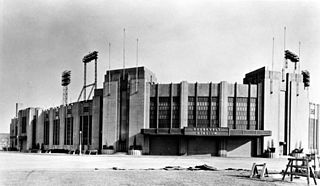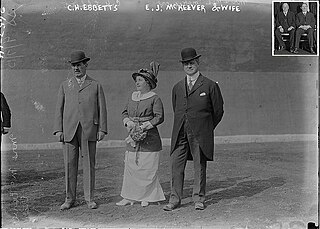Related Research Articles

The Brooklyn Dodgers were an American football team that played in the National Football League from 1930 to 1943, and in 1944 as the Brooklyn Tigers. The team played its home games at Ebbets Field of the baseball National League's team, the Brooklyn Dodgers. In 1945, because of financial difficulties and the increasing scarcity of major league–level players because of the war-time defense requirements at the height of World War II, the team was merged with the Boston Yanks and were known as the Yanks for that season.

Ebbets Field was a Major League Baseball stadium in the Flatbush section of Brooklyn, New York. It is mainly known for having been the home of the Brooklyn Dodgers baseball team of the National League (1913–1957). It was also home to five professional football teams, including three NFL teams (1921–1948). Ebbets Field was demolished in 1960 and replaced by the Ebbets Field Apartments, the site's current occupant.

Washington Park was the name given to three Major League Baseball parks on two different sites in the Park Slope neighborhood of Brooklyn, New York, located at the intersection of Third Street and Fourth Avenue. The two sites were diagonally opposite each other, on the southeast and northwest corners.

Walter Francis O'Malley was an American sports executive who owned the Brooklyn / Los Angeles Dodgers team in Major League Baseball from 1950 to 1979. In 1958, as owner of the Dodgers, he brought major league baseball to the West Coast, moving the Dodgers from Brooklyn to Los Angeles despite the Dodgers being the second most profitable team in baseball from 1946 to 1956, and coordinating the move of the New York Giants to San Francisco at a time when there were no teams west of Kansas City, Missouri. In 2008, O'Malley was elected to the National Baseball Hall of Fame for his contributions to and influence on the game of baseball.

Roosevelt Stadium was a baseball stadium at Droyer's Point in Jersey City, New Jersey. It opened in April 1937 and served as the home of the Jersey City Giants of the International League (1937–1950) and hosted other high-minor league baseball. It also hosted 15 Major League Baseball home games for the Brooklyn Dodgers (1956–1957), plus championship boxing matches, top-name musical acts, an annual championship drum and bugle corps competition known as "The Dream" (1946–1983), important regional high school football and even soccer matches. It was demolished in 1985.

Charles Henry Ebbets, Sr. was an American sports executive who served as co-owner of the Brooklyn Dodgers from 1897 to 1902 before becoming majority owner of the team, doing so until his death in 1925. He also served as president of the Brooklyn Dodgers from 1898 to 1925.

Interstate 95 (I-95) is part of the Interstate Highway System and runs from Miami, Florida, to the Canada–United States border near Houlton, Maine. In the US state of New York, I-95 extends 23.50 miles (37.82 km) from the George Washington Bridge in New York City to the Connecticut state line at Port Chester. The George Washington Bridge carries I-95 across the Hudson River from New Jersey into New York City. There, I-95 runs across Upper Manhattan on the Trans-Manhattan Expressway for 0.81 miles (1.30 km) through Washington Heights. It continues east across the Harlem River on the Alexander Hamilton Bridge and onto the Cross Bronx Expressway. In the Bronx, I-95 leaves the Cross Bronx at the Bruckner Interchange, joining the Bruckner Expressway to its end. North of the interchange with Pelham Parkway, it then continues northeast via the New England Thruway out of New York City into Westchester County and to the Connecticut state line, where I-95 continues on the Connecticut Turnpike.

The Battle of Chavez Ravine refers to resistance to the government acquisition of land largely owned by Mexican-Americans in Los Angeles' Chavez Ravine. The efforts to repossess the land, which lasted approximately ten years (1951–1961), eventually resulted in the removal of the entire population of Chavez Ravine from land on which Dodger Stadium was constructed. The majority of the Chavez Ravine land was initially acquired by eminent domain by the City of Los Angeles to make way for proposed public housing. The public housing plan that had been advanced as politically "progressive" and had resulted in the removal of the Mexican-American landowners of Chavez Ravine was abandoned after the passage of a public referendum prohibiting the original housing proposal and the election of a conservative Los Angeles mayor opposed to public housing. By 1958, the public housing plans were abandoned and the land was conveyed by the city to the Dodgers. The new plans were advanced to construct Dodger Stadium on the site, and in 1959, the Los Angeles County Sheriff's Department forcefully removed the last residents occupying Chavez Ravine.

Daniel Eugene McDevitt was an American pitcher in Major League Baseball who played from 1957 through 1962 for the Brooklyn/Los Angeles Dodgers, New York Yankees, Minnesota Twins and Kansas City Athletics. The left-hander was listed at 5 feet 10 inches (1.78 m) tall and 170 pounds (77 kg).
The 1957 Brooklyn Dodgers season was overshadowed by Walter O'Malley's threat to move the Dodgers out of Brooklyn if the city did not build him a new stadium in that borough. When the best the mayor could promise was a stadium in Queens, O'Malley made good on his threats and moved the team to Los Angeles after the season ended. The Dodgers final game at Ebbets Field was on September 24 as they finished their 68th and last NL season, and their 75th overall, in Brooklyn in third place with an 84–70 record, 11 games behind the NL and World Series Champion Milwaukee Braves.
The 1956 Brooklyn Dodgers edged out the Milwaukee Braves to win the National League title. The Dodgers again faced the New York Yankees in the World Series. This time they lost the series in seven games, one of which was a perfect game by the Yankees' Don Larsen.

The Brooklyn Sports Center, in retrospect known as the Dodger Dome, was a proposed domed stadium for the Brooklyn Dodgers, designed by Buckminster Fuller to replace Ebbets Field. Meant to keep the Dodgers in New York City, it was first announced in the early 1950s. The envisioned structure would have seated 52,000 people and been the first domed stadium in the world, opening roughly a decade before Houston's Astrodome. The Dodgers instead moved to Chavez Ravine in Los Angeles.
George Washington Chauncey was an American business executive in banking and real estate. He was also an owner in professional baseball, owning a franchise during the only season of the Players' League, 1890, and being an early part-owner of the team that would become the Brooklyn Dodgers, during 1891–1896.

Edward J. McKeever was a construction contractor in Brooklyn in the early 20th-century. McKeever and his brother Stephen bought half of the Brooklyn Dodgers baseball team from Henry Medicus on January 2, 1912. Together with co-owner Charles Ebbets, they built what became Ebbets Field. McKeever served as vice-president of the Dodgers until Charles Ebbets died of a heart attack on April 18, 1925. McKeever became team president, but despite previously being in good health, he caught a cold at Ebbets' funeral and died of influenza a little more than a week later. He was buried in Holy Cross Cemetery in Brooklyn.

Stephen W. McKeever was a construction contractor in Brooklyn, New York in the early 1900s. He and his brother Ed bought half of the Brooklyn Dodgers baseball team from Henry Medicus on January 2, 1912. Together with Charles Ebbets, who owned the other half of the team, they built Ebbets Field. When Ebbets died on April 18, 1925, Ed McKeever took over as team president. However, he caught a cold at Ebbets' funeral and died on April 29. Steve McKeever became the acting team president until Wilbert Robinson was elected team president on May 25, 1925. Steve McKeever was elected team president on October 12, 1932, and remained a 50% owner of the Dodgers until his death in 1938. He was buried in Holy Cross Cemetery in Brooklyn.

The Brooklyn Dodgers were a Major League Baseball team founded in 1883 as the Brooklyn Grays, next year in 1884 becoming a member of the American Association as the Brooklyn Atlantics before joining the National League in 1890. They remained in Brooklyn until 1957, after which the club moved to Los Angeles, California, where it continues its history as the Los Angeles Dodgers. The team moved west at the same time as its longtime rival, the New York Giants, moved to San Francisco in northern California as the San Francisco Giants.
Clarence H. Adams was an American government official and businessman who served as a commissioner of the U.S. Securities and Exchange Commission from 1952 to 1956.

Hilda Chester, also known as Howlin' Hilda, was a fan of the Brooklyn Dodgers baseball team, and arguably the most famous fan in baseball history.

The Bridge Apartments are four high-rise apartment buildings in the Washington Heights neighborhood of Manhattan, New York. Built between 1961 and 1964, they are notable for rising from concrete platforms directly above the Trans-Manhattan Expressway on its approach to the George Washington Bridge. Their proximity to the highway has led residents to complain of traffic noise and air pollution. The four buildings, each 32 stories tall, house about 4,000 people in total.
References
- 1 2 3 4 5 6 7 8 9 Nick Ravo (December 9, 1999). "Marvin Kratter, 84; Once Owned Ebbets Field". The New York Times . Retrieved 2010-03-14.
- ↑ Jewish Telegraph Agency: "Marvin Kratter Named Chairman of 1962 Joint Defense Appeal Campaign" March 30, 1962
- ↑ "Liberal Education - Google Books". 2006-05-19. Retrieved 2019-12-25.
- ↑ Nagle, James J. (August 25, 1963). "Personality: Real Estate Man Now Brewer; Company Head Also Likes Devices That Save Labor Marvin Kratter Has a Fondness for Unusual Deals Move Opposed Likes Folk Dancing Lights Donated". The New York Times.
- ↑ "Real Estate Tycoon Buys Ebbets Field," The Associated Press (AP), Wednesday, October 31, 1956. Retrieved March 3, 2023.
- ↑ "Time Clock, November 12, 1956," TIME (magazine), Monday, Nov. 12, 1956. Retrieved March 3, 2023.
- ↑ New York Times: "Rosenblum—Eva" April 5, 1964, p. 87. "The Officers, Directors and Employes of The Kratter Corporation extend their heartfelt sympathy to Mrs. Lillian Kratter, wife of our esteemed President and Chairman of the Board, Marvin Kratter, on the loss of her mother, Mrs. Eva Rosenblum. The Kratter Corporation"